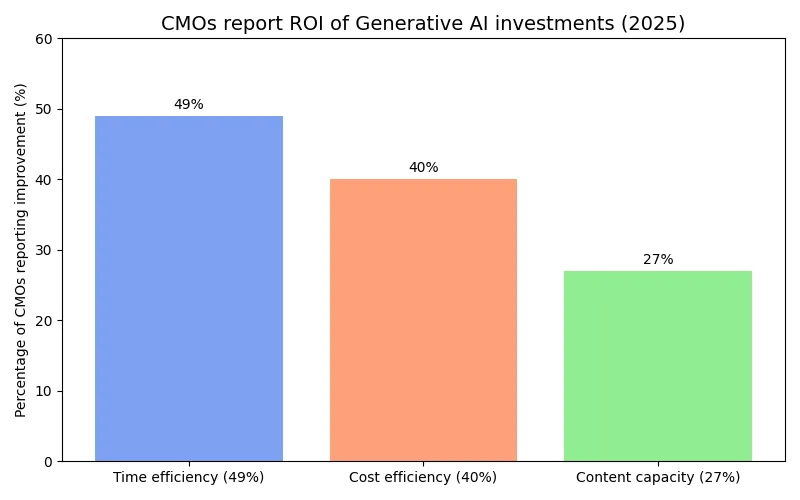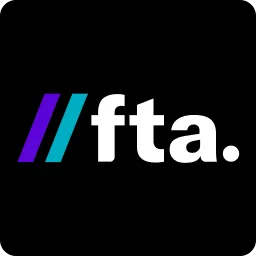Beyond Templates: How to Direct AI Like a Human Creative Lead
How to Direct Generative AI Like a Human Creative Lead
Generative AI has moved from novelty to necessity. Over the past few years AI has become part of every marketer’s toolbox, moving from curiosity to everyday companion. Yet there’s a gap between using it like a shortcut and leading it like a junior team member.
Despite this rapid adoption, budgets have not grown. Gartner’s CMO Spend Survey shows marketing budgets remain stuck at 7.7% of company revenue, with 59% of CMOs saying they lack sufficient funds to execute their strategies. To stay competitive under these constraints, marketing leaders are leaning on automation without using ample human creativity.
That’s the gap this guide aims to bridge. We’ve spent hundreds of hours experimenting with generative tools and the biggest surprise wasn’t the output, but how much the human mind still matters. When you let the machine do all the thinking you get generic results. When you provide a clear brief, refine its drafts and add your taste, you unlock campaigns that feel fresh and on brand.
In a world where budgets are tight and expectations high, automation can help you move faster. But speed without direction is just noise. True performance comes from pairing AI with a creative lead who knows the brand inside out.
This conversation sets the stage for a discussion on how to guide AI rather than being guided by it, how to keep your unique voice in a landscape flooded with machine‑generated content, and how to build systems that let you scale without losing your edge.
The Problem with Vending-Machine AI
The convenience of AI hides a deeper problem. Too many marketers treat it like a vending machine type in a keyword-stuffed prompt and take whatever comes out. This “template” mindset delivers speed but creates sameness.
Dark social private messages, email shares and community conversations already accounts for about 71 percent of all social sharing. Over 70% of a buyer’s journey happens before they ever contact a brand. In a world where most touchpoints are invisible, templated AI content blends into the noise.
Why the Shift Matters
- Flat budgets, rising pressure
Marketing budgets have stagnated at 7.7% of company revenue. More than half of CMOs feel under-resourced. Paid media still consumes over 30% of budgets, yet reach and impact continue to shrink. - AI adoption is mainstream, but skills lag
With nearly all businesses investing in generative AI, the technology is no longer a differentiator. Yet 43 percent of adopters say they don’t know how to maximize AI’s value, and 39 percent admit they don’t know how to use it safely. This skill gap creates opportunity for strong creative leadership. - Generative AI is delivering ROI
CMOs report efficiency gains in time, cost and content output. However, focusing solely on efficiency hides the long-term risk of creative sameness and brand dilution. - Hidden funnels and dark social
Since most of the buyer’s journey happens before brand contact, traditional attribution models are breaking down. CMOs must focus on behavioural data such as revisit rates, scroll depth and repeat sessions instead of clicks.

From Prompts to Direction
To unlock AI’s true potential, creative leads must move from template-driven execution to direction-driven creation. Treat AI like a junior creative, not a vending machine.
1. Set clear intent
Before generating anything, define purpose, audience and emotion. A clear brief shapes tone and style. Instead of saying “Create an ad for athletic shoes,” a better prompt would be “Produce a 15-second video showing a female marathon runner training at dawn, focusing on resilience and comfort.”
2. Build an iterative loop
Strong creative work comes from iteration. Use AI to produce multiple drafts, then review and refine. Ask why something feels off-brand or lacks emotion, then adjust. Direction means dialogue, not one-shot outputs.
3. Apply creative judgment
AI can create hundreds of variations but cannot decide what feels authentic or culturally relevant. Your taste, experience and understanding of brand context are irreplaceable. Use them to filter and elevate what AI produces.
Understanding AI Input Types
Modern AI platforms go beyond text prompts. They now allow creators to work with multiple input types:
Input Method
Description
Best Used For
Text to video
Start with a text prompt to generate a complete clip.
Drafting storyboards or concepts.
Frames to video
Provide starting and ending frames to create continuity.
Building sequences or product demos.
Ingredients to video
Combine multiple assets like images, audio and motion paths.
Crafting branded environments or narratives.
Comparing Veo 3, Kling AI and Flow - Some of the most advanced video generation tools
This table compares Veo 3, Kling, and Flow - three leading generative video tools shaping modern creative workflows. Thus, highlighting how each serves a distinct role in the production pipeline
Feature / Aspect
Veo 3
Kling
Flow
Purpose
High-end cinematic video generation for polished campaign output
Precision-based frame-to-video creation for motion accuracy
Creative sequencing and storytelling tool for fast experimentation
Core Strength
Exceptional visual realism with advanced lighting, texture, and motion
Strong motion realism with accurate physics and start–end frame consistency
Efficient editing and scene chaining with strong narrative continuity
Audio Capabilities
Generates ambient sound, background score, and dialogue natively
Limited in-built audio, focused on motion quality
Integrates audio externally; focused on sequencing and storytelling
Cinematic Understanding
Understands film language like aerial shots, slow motion, time lapse
Focused on realism in motion and physics; not cinematic control
Controls camera transitions and scene continuity for structured storytelling
Output Quality
Polished, production-ready visuals suited for final campaign films
Clean, realistic motion outputs ideal for mid-production visuals
Balanced, quick-turn creative outputs for drafts and concept videos
Editing & Control
Limited editing; focuses on full-scene generation
Moderate flexibility with camera and transition adjustments
High flexibility with clip-level editing and visual continuity
Integration
Native integration with Gemini ecosystem for end-to-end video creation
Works efficiently with start and end frame inputs to maintain flow
Unified editing environment to combine clips and assets
Ease of Storytelling
Produces cohesive, cinematic brand narratives with high realism
Builds consistent motion across shots, supports continuity
Enables creative exploration through structured storyboarding
Cost & Accessibility
Premium-grade tool designed for agencies and professional studios
Cost-effective option delivering strong motion and visual quality
Accessible and efficient for creators needing agility and iteration
Ideal Use Case
Final promotional films, cinematic storytelling, high-end brand videos
Experimental visual storytelling with precise motion
Quick iterations, pre-visualization, and creative concept development
The Motion Brush Advantage
The Motion Brush tool adds a layer of creative control that text prompts cannot. Instead of describing movement in words, directors can draw the desired motion paths like sketching how a camera pans across a scene or how a character moves across the frame.
This visual approach turns AI into a responsive cinematographer. It’s particularly useful in storytelling campaigns, such as FTA Global’s Independence Day video for Zoomcar, where the team used motion brushes to choreograph subtle movements and transitions that aligned with the brand’s emotional tone.
The magic was not in the prompts but in how the AI was directed toward a unified narrative.
Leading AI with Structured Prompts
Not all prompts are equal. High-performing creative leads use structured frameworks that balance clarity and flexibility. Build prompt libraries and tone codexes that encode your brand voice, vocabulary and style.
A structured prompt typically includes:
- Scene description: Define setting, characters, emotion and action.
- Technical constraints: Include details like aspect ratio, frame rate, colour palette or camera movement.
- Sensory cues: Add lighting, sound or atmosphere to make outputs feel real.
As AI platforms evolve, prompts will become shorter and more intuitive. Tools like Veo 3 already interpret concise instructions or even sketches. Still, intent matters more than syntax. The strength of direction always outweighs the cleverness of wording.
Coca-Cola’s “Create Real Magic” campaign
Coca-Cola partnered with OpenAI to let fans remix classic Coke imagery using DALL-E and ChatGPT. The project combined nostalgia with innovation and showed how AI can co-create with audiences under strong narrative leadership.

(redesign in same aspect ratio)
Creativity needs systems and supply chains at scale
- Codify brand tone
Build a tone codex that translates brand personality into clear AI guidelines - preferred words, pacing, humour and visual identity. - Create prompt libraries
Maintain modular prompt fragments for intros, CTAs and sensory details. This allows teams to mix and match without losing consistency. - Design creative pods
Form teams that include AI operators, strategists, designers and analysts. Establish feedback loops for tone, compliance and performance. This system mirrors how global brands like Nestlé and L’Oréal manage large-scale AI-assisted campaigns while keeping voice consistency. - Apply the 80/20 rule
Let AI handle 80% of production tasks - variations, resizing, translations and reserve 20% for human refinement. According to Bain, this approach can reduce campaign time to market by 50% and cut content creation time by up to half. - Measure what matters
Move beyond CTRs and last-click ROAS. Track revisit rates, scroll depth, page sequences and conversion lag. Self-reported “How did you hear about us?” data helps reveal dark social influence that analytics miss.
AI Raises the Bar, Creative Leaders Lift It Higher
Generative AI is not replacing creative professionals it’s elevating expectations.
With budgets flat and channels crowded, success now depends on how well creative leaders direct AI, not just use it.
Stop treating AI like a vending machine. Lead with intent, iterate often, and apply judgment. Systemize your creativity through tone codexes and prompt libraries. Measure behaviour and engagement, not just clicks.
The creative lead of the future is part conductor, part storyteller and part technologist. When you orchestrate AI with clarity and imagination, you move beyond templates and create work that connects with people both in public feeds and in the unseen corners of the digital journey.




